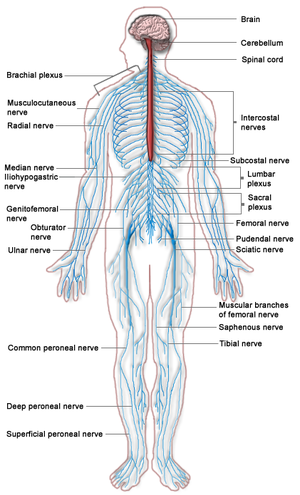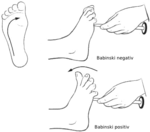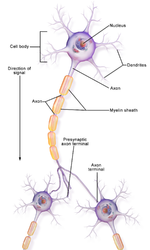Neurodynamics: Difference between revisions
Evan Thomas (talk | contribs) No edit summary |
(ADDING NEW REFERENCE and REVIEW) |
||
| (37 intermediate revisions by 8 users not shown) | |||
| Line 2: | Line 2: | ||
'''Original Editor '''- [[User:Rachael Lowe|Rachael Lowe]] | '''Original Editor '''- [[User:Rachael Lowe|Rachael Lowe]] | ||
''' | '''Top Contributors''' - {{Special:Contributors/{{FULLPAGENAME}}}} | ||
</ | </div> | ||
== Neurodynamics == | |||
[[File:Nervous system diagram.png|right|frameless]]Neurodynamics refers to the communication between different parts of the nervous system and to the nervous systems relationship to the musculoskeletal system. It has been shown that the nerves move independently from other tissues.<ref name=":0">Lohkamp M., Herrington L. Small K. Tidy's physiotherapy. London Elsevier 2013</ref> | |||
Neurodynamics in the sense implied here is the mobilisation of the nervous system as an approach to physical treatment of pain. The treatment and or assessment relies on influencing pain physiology ''via'' the mechanical treatment of neural tissues and non-neural structures surrounding the nervous system. This mobilisation activates a range of mechanical and physiological responses in nervous tissues. eg neural sliding, pressurisation, elongation, tension and changes in intraneural microcirculation, axonal transport and nervous impulse movements.<ref>Shacklock M. Neurodynamics. Physiotherapy. 1995 Jan 1;81(1):9-16. Available from: https://www.physiotherapyjournal.com/article/S0031-9406(05)67024-1/pdf (last accessed 16.4.2019)</ref> | |||
Neural mobilization to treat neurodynamic dysfunction to date is still needing justifcation through research of high quality homogenous studies. To date however most studies have shown positive therapeutic effects through the use of neurodynamic treatment. <ref>Ellis RF, Hing WA. [https://www.ncbi.nlm.nih.gov/pmc/articles/PMC2565076/ Neural mobilization: a systematic review of randomized controlled trials with an analysis of therapeutic efficacy.] Journal of manual & manipulative therapy. 2008 Jan 1;16(1):8-22. Available from: https://www.ncbi.nlm.nih.gov/pmc/articles/PMC2565076/ (last accessed 16.4.2019)</ref> | |||
== Neural Basics == | == Neural Basics == | ||
To apply the principles of neurodynamics, a good understanding of the neural basics, as defined below, is needed. | |||
*[[Introduction to Neuroanatomy|Neuroanatomy]] | |||
*Neurophysiology - study of the function of the nervous system. | |||
*Neurobiomechanics - based on the research of bioengineering researchers, neuro-surgery, orthopaedic surgery and biomechanisms, then utilised by neurosurgeons, orthopaedic surgeons and by integrated physical medicine practitioners (eg. physiotherapists, chiropractors, nurse practitioners). These practitioners focus on aiding people in the restoration of biomechanics of the skeletal system in order to measurably improve nervous system function, health, function, quality of life, reduce pain and the progression of degenerative joint and disc disease.<ref>Wikipedia. [https://en.wikipedia.org/wiki/Neuro_biomechanics Neuro biomechanics.] Available from: https://en.wikipedia.org/wiki/Neuro_biomechanics (last accessed 20.4.2019)</ref> | |||
*Neuropathology- study of diseases of the nervous system. | |||
== Two fold Neural Examination involving == | |||
[[File:Babinski's.png|right|frameless|150x150px]] | |||
== Neural Examination == | == 1.Neural (Traditional) Examination [[File:H Reflex Testing.jpg|frameless|133x133px]] == | ||
*Neural Subjective | *[[:Category:Neurological - Assessment and Examination|Neural Subjective]] | ||
*Dermatomes | *[[Dermatomes]] and [[myotomes]] | ||
* | *[[Muscle Strength Testing|Muscle strength]] | ||
*Reflexes | *[[Reflexes]] | ||
*[[Romberg Test|Romberg’s Test]] | *[[Romberg Test|Romberg’s Test]] | ||
*Babinski’s Reflex | *[[Babinski Sign|Babinski’s Reflex]] ( Plantar response) | ||
*see also [[:Category:Neurological - Assessment and Examination|Neurology assessment]] | |||
== 2.Neural Provocation Tests [[File:Scheuermann's Kyphosis Pectoral Stretch.jpg|frameless|150x150px]] == | |||
For a guide to the below tests, look to the one link [[Neurodynamic Assessment|here Neurodynamic Assessment]] | |||
*ULTT1 (median nerve bias) | *ULTT1 (median nerve bias) | ||
*ULTT2a (median nerve bias | *[[File:Neuron Part 1.png|right|frameless|250x250px]]ULTT2a (median nerve, musculocutaneous nerve and axillary nerve bias) | ||
*ULTT2b (radial nerve bias) | *ULTT2b (radial nerve bias) | ||
*ULTT3 (ulnar nerve bias) | *ULTT3 (ulnar nerve bias) | ||
| Line 31: | Line 40: | ||
*[[Femoral Nerve Tension Test|PKB]] (femoral nerve bias) | *[[Femoral Nerve Tension Test|PKB]] (femoral nerve bias) | ||
*[[Slump Test|Slump]] (dura) | *[[Slump Test|Slump]] (dura) | ||
== Conditions with neurodynamic involvement == | == Conditions with neurodynamic involvement == | ||
A few examples | |||
[[Ankle Sprain|Ankle sprain]]; Cervical and Lumbar [[Nerve entrapment|Nerve Root Injury]]; [[Colles Fracture|Colles Fracture]]; [[Carpel Tunnel Syndrome|Carpel Tunnel Syndrome]]; [[Failed Back Surgery Syndrome|Failed Back Surgery Syndrome]]; [[Hamstring Muscle Strain|Hamstring Injury]] <ref>López LL, Torres JR, Rubio AO, Sánchez IT, Martos IC, Valenza MC. Effects of neurodynamic treatment on hamstrings flexibility: A systematic review and meta-analysis. Physical Therapy in Sport. 2019 Nov 1;40:244-50.</ref> ; [[Meralgia Paraesthetica|Meralgia Paresthetica]]; [[Myelopathy|Myelopathy]]; [[Plantarfasciitis|Plantarfasciitis]]; Post [[Lumbar Fusion Rehabilitation|Lumbar Surgery]]; [[Whiplash Associated Disorders|Whiplash Associated Disorders]]; [[Thoracic Outlet Syndrome (TOS)|Thoracic Outlet Syndrome]]; [[Sciatica]];[[Cyclist's palsy|Cyclists Palsy]]; [[Double Crush Syndrome|Double crush syndrome]]; [[Tarsal Tunnel Syndrome]] | |||
== Presentations == | == Presentations == | ||
<div class="coursebox"> | For an indepth look at neurodynamic testing look at the below resources.<div class="coursebox"> | ||
{| width="100%" cellspacing="4" cellpadding="4" border="0 | {| class="FCK__ShowTableBorders" width="100%" cellspacing="4" cellpadding="4" border="0" | ||
|- | |- | ||
| align="center" | <imagemap> | | align="center" | <imagemap> | ||
| Line 61: | Line 56: | ||
</imagemap> | </imagemap> | ||
| [http://www.eimqa.com/Fellowship/FellowPresent/KargelaUENeurodynamics.mov '''Upper Limb Neurodynamics'''] | | [http://www.eimqa.com/Fellowship/FellowPresent/KargelaUENeurodynamics.mov '''Upper Limb Neurodynamics'''] | ||
This presentation, created by Mark Kargela as part of the [[ | This presentation, created by Mark Kargela as part of the [[EIM Orthopaedic Manual Physical Therapy Fellowship Project|OMPT Fellowship]], discusses the upper limb neurodynamics. | ||
[http://www.eimqa.com/Fellowship/FellowPresent/KargelaUENeurodynamics.mov View the presentation] | [http://www.eimqa.com/Fellowship/FellowPresent/KargelaUENeurodynamics.mov View the presentation] | ||
| Line 67: | Line 62: | ||
|} | |} | ||
</div> | </div> | ||
<div class="coursebox"> | |||
{| class="FCK__ShowTableBorders" width="100%" cellspacing="4" cellpadding="4" border="0" | |||
|- | |||
| align="center" | <imagemap> | |||
Image:Cervicothoracic disorders ppt.PNG|200px|border|left| | |||
rect 0 0 830 452 [https://vimeo.com/65773894] | |||
desc none | |||
</imagemap> | |||
| [https://vimeo.com/65773894 '''Adverse Neural Dynamics Related to Cervicothoracic Disorders and Symptoms'''] | |||
This presentation, created by Damian Rodriguez, Allison Rose, David Self, Blake Spoon; Texas State DPT Class. | |||
[https://vimeo.com/65773894/ View the presentation] | |||
|} | |||
</div> <div class="coursebox"> | |||
{| class="FCK__ShowTableBorders" width="100%" cellspacing="4" cellpadding="4" border="0" | |||
|- | |||
| align="center" | <imagemap> | |||
Image:Adverse neural dynamics presentation title.png|200px|border|left| | |||
rect 0 0 830 452 [http://www.eimqa.com/Fellowship/FellowPresent/KargelaUENeurodynamics.mov] | |||
desc none | |||
</imagemap> | |||
| [https://youtu.be/BfX65uOkLg0 '''Adverse Neural Dynamics: Treatment Considerations for Neck and Arm Pain'''] | |||
This presentation, created by Jason Grandeo, as part of the [[EIM Orthopaedic Manual Physical Therapy Fellowship Project|OMPT Fellowship]], discusses the adverse neurodynamics in the upper quadrant. | |||
[https://youtu.be/BfX65uOkLg0/ View the presentation] | |||
|} | |||
</div> | |||
<div class="coursebox"> | |||
{| class="FCK__ShowTableBorders" width="100%" cellspacing="4" cellpadding="4" border="0" | |||
|- | |||
| align="center" | <imagemap> | |||
Image:Adverse neural dynamics upper ex exam presentation title.png|200px|border|left| | |||
rect 0 0 830 452 [https://youtu.be/QuPVnj7XPjY] | |||
desc none | |||
</imagemap> | |||
| [https://youtu.be/QuPVnj7XPjY '''Adverse Neural Dynamics - Upper Extremity Examination'''] | |||
This presentation, created by Jason Grandeo, as part of the [[EIM Orthopaedic Manual Physical Therapy Fellowship Project|OMPT Fellowship]], reviews indications for using upper-limb neurodynamic tests, describes normal sensory responses for each of the upper limb neurodynamic tests, reviews the validity of the upper limb neurodynamic tests, and describes positive findings with upper limb neurodynamic tests. | |||
[https://youtu.be/QuPVnj7XPjY/ View the presentation] | |||
|} | |||
</div> | |||
[[Category:Assessment]] | |||
[[Category:Neurodynamics]] | |||
[[Category:Primary Contact]] | |||
<references /> | |||
Latest revision as of 12:10, 5 October 2023
Original Editor - Rachael Lowe
Top Contributors - Evan Thomas, Lucinda hampton, Kim Jackson, Admin, Rachael Lowe, Laura Ritchie, Claire Knott, Rucha Gadgil, Joshua Samuel and Shaimaa Eldib
Neurodynamics[edit | edit source]
Neurodynamics refers to the communication between different parts of the nervous system and to the nervous systems relationship to the musculoskeletal system. It has been shown that the nerves move independently from other tissues.[1]
Neurodynamics in the sense implied here is the mobilisation of the nervous system as an approach to physical treatment of pain. The treatment and or assessment relies on influencing pain physiology via the mechanical treatment of neural tissues and non-neural structures surrounding the nervous system. This mobilisation activates a range of mechanical and physiological responses in nervous tissues. eg neural sliding, pressurisation, elongation, tension and changes in intraneural microcirculation, axonal transport and nervous impulse movements.[2]
Neural mobilization to treat neurodynamic dysfunction to date is still needing justifcation through research of high quality homogenous studies. To date however most studies have shown positive therapeutic effects through the use of neurodynamic treatment. [3]
Neural Basics[edit | edit source]
To apply the principles of neurodynamics, a good understanding of the neural basics, as defined below, is needed.
- Neuroanatomy
- Neurophysiology - study of the function of the nervous system.
- Neurobiomechanics - based on the research of bioengineering researchers, neuro-surgery, orthopaedic surgery and biomechanisms, then utilised by neurosurgeons, orthopaedic surgeons and by integrated physical medicine practitioners (eg. physiotherapists, chiropractors, nurse practitioners). These practitioners focus on aiding people in the restoration of biomechanics of the skeletal system in order to measurably improve nervous system function, health, function, quality of life, reduce pain and the progression of degenerative joint and disc disease.[4]
- Neuropathology- study of diseases of the nervous system.
Two fold Neural Examination involving[edit | edit source]
1.Neural (Traditional) Examination 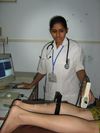 [edit | edit source]
[edit | edit source]
- Neural Subjective
- Dermatomes and myotomes
- Muscle strength
- Reflexes
- Romberg’s Test
- Babinski’s Reflex ( Plantar response)
- see also Neurology assessment
2.Neural Provocation Tests 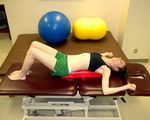 [edit | edit source]
[edit | edit source]
For a guide to the below tests, look to the one link here Neurodynamic Assessment
- ULTT1 (median nerve bias)
- ULTT2a (median nerve, musculocutaneous nerve and axillary nerve bias)
- ULTT2b (radial nerve bias)
- ULTT3 (ulnar nerve bias)
- PNF (Lhermitte’s Test)
- SLR (sciatic, tibial, and peroneal nerve biases)
- PKB (femoral nerve bias)
- Slump (dura)
Conditions with neurodynamic involvement[edit | edit source]
A few examples
Ankle sprain; Cervical and Lumbar Nerve Root Injury; Colles Fracture; Carpel Tunnel Syndrome; Failed Back Surgery Syndrome; Hamstring Injury [5] ; Meralgia Paresthetica; Myelopathy; Plantarfasciitis; Post Lumbar Surgery; Whiplash Associated Disorders; Thoracic Outlet Syndrome; Sciatica;Cyclists Palsy; Double crush syndrome; Tarsal Tunnel Syndrome
Presentations[edit | edit source]
For an indepth look at neurodynamic testing look at the below resources.
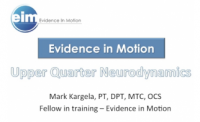 |
Upper Limb Neurodynamics
This presentation, created by Mark Kargela as part of the OMPT Fellowship, discusses the upper limb neurodynamics. |
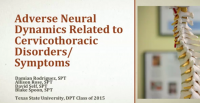 |
Adverse Neural Dynamics Related to Cervicothoracic Disorders and Symptoms
This presentation, created by Damian Rodriguez, Allison Rose, David Self, Blake Spoon; Texas State DPT Class. |
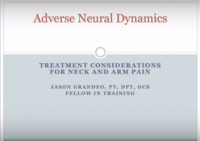 |
Adverse Neural Dynamics: Treatment Considerations for Neck and Arm Pain
This presentation, created by Jason Grandeo, as part of the OMPT Fellowship, discusses the adverse neurodynamics in the upper quadrant. |
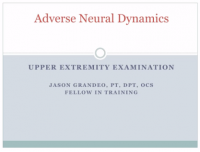 |
Adverse Neural Dynamics - Upper Extremity Examination
This presentation, created by Jason Grandeo, as part of the OMPT Fellowship, reviews indications for using upper-limb neurodynamic tests, describes normal sensory responses for each of the upper limb neurodynamic tests, reviews the validity of the upper limb neurodynamic tests, and describes positive findings with upper limb neurodynamic tests. |
- ↑ Lohkamp M., Herrington L. Small K. Tidy's physiotherapy. London Elsevier 2013
- ↑ Shacklock M. Neurodynamics. Physiotherapy. 1995 Jan 1;81(1):9-16. Available from: https://www.physiotherapyjournal.com/article/S0031-9406(05)67024-1/pdf (last accessed 16.4.2019)
- ↑ Ellis RF, Hing WA. Neural mobilization: a systematic review of randomized controlled trials with an analysis of therapeutic efficacy. Journal of manual & manipulative therapy. 2008 Jan 1;16(1):8-22. Available from: https://www.ncbi.nlm.nih.gov/pmc/articles/PMC2565076/ (last accessed 16.4.2019)
- ↑ Wikipedia. Neuro biomechanics. Available from: https://en.wikipedia.org/wiki/Neuro_biomechanics (last accessed 20.4.2019)
- ↑ López LL, Torres JR, Rubio AO, Sánchez IT, Martos IC, Valenza MC. Effects of neurodynamic treatment on hamstrings flexibility: A systematic review and meta-analysis. Physical Therapy in Sport. 2019 Nov 1;40:244-50.
